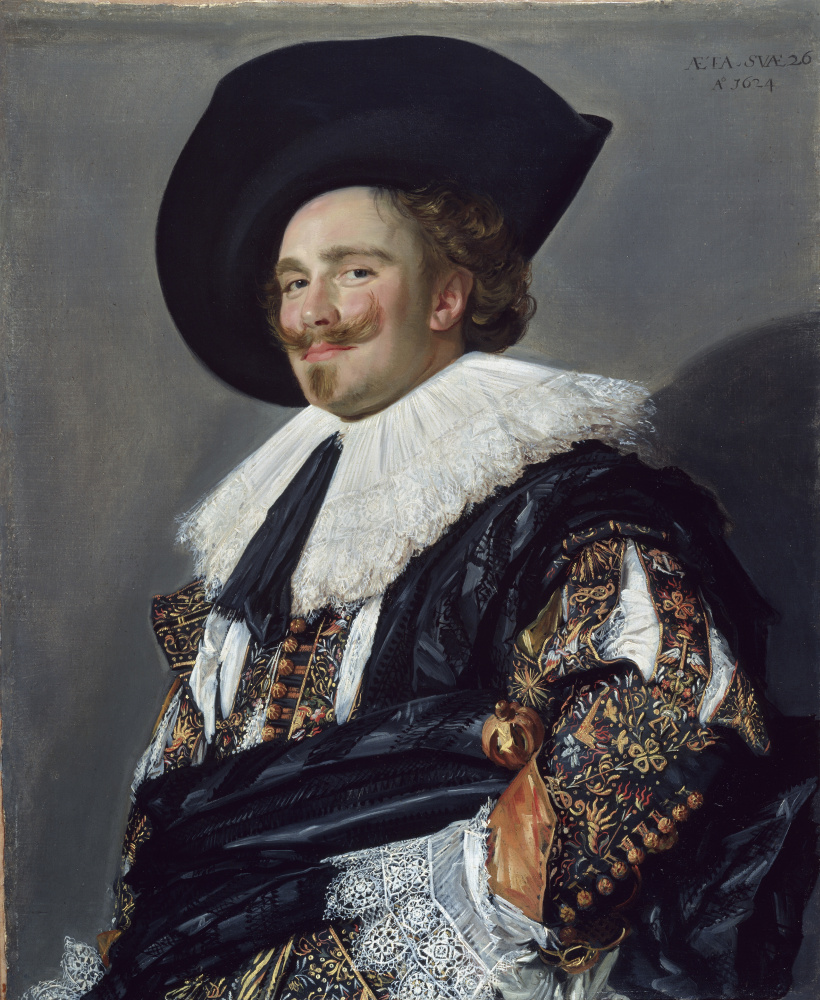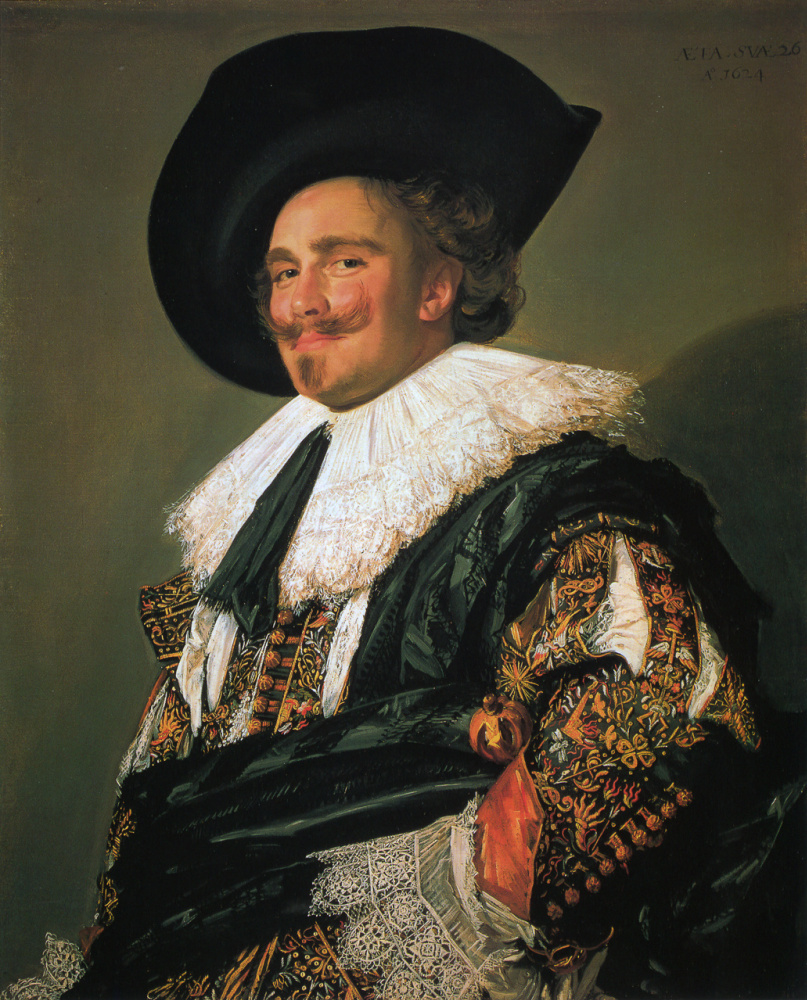log in
Enter site
Login to use Arthive functionality to the maximum
The laughing cavalier
Frans Hals • Painting, 1624, 83×67.3 cm
Description of the artwork «The laughing cavalier»
"The laughing cavalier" – this lush portrait of a young man standing in a deliberately casual pose on a simple gray background. In the upper right corner listed his age 26 years and date of painting – 1624. This work is unique among the male portraits of Frans Hals, with a rich color palette. Particularly noteworthy is the bright costume of the sitter – doublet with fancy embroidery white, gold and red thread and gold plated hilt rapier, peering from under the left elbow.
Neither the identity of the young man nor the purpose of the portrait is unknown certainly, but some important clues, researchers can give a dazzling costume. Embroidery motifs on the doublet identified as common in those days, the emblems and symbols of pleasure and the pangs of love – arrows, flaming horn of plenty, and the bonds of lovers. These allusions to love Affairs and courtship suggests that we face wedding portrait. However not found for the fresh image.
Also it was suggested that some elements on the costume (especially the caduceus, the attribute of the Roman God mercury) point to the trade. A reputable art historian Peter Biesboer recently suggested that the sitter was a Thielemann, Rosterman, a wealthy textile merchant from Harlem.
By 1624, the Hals has written several singles and doubles portraits and the group portrait "Banquet of the officers of the Harlem shooting Guild of St. George". The latter is perhaps the most famous work of the painter, showing his masterly ability to convey the vitality and spirit of their models.
A representative form the "Laughing cavalier" due to the fact that the artist has placed it in close proximity to the audience and depicted with the lowest point. The hand rests on the thigh, is also a distinctive feature of the male portraits Hals – so it shows the confidence of the sitters in itself. In addition, this position gives the pattern visual depth. The portrait is painted with different strokes, from a subtle merging of lines on the face to a more broad, free strokes on the suit.
Details delicate lace from a distance they look elaborate, but close to be a fast sketch. It may seem that the broad lines of the hands and the folds of drapery over the man's abdomen was written in just a few seconds long fast strokes. There is something excessive in combination ruddy complexion and a mass of silks and lace. The hero of portrait of the real and unreal at the same time.
By the early nineteenth century creativity Hals was almost forgotten. Despite this, the canvas "the Laughing cavalier" was the subject of a fierce battle between Richard Seymour Conway, 4th Marquis of Hertford and Baron James de Rothschild at a Paris auction in 1865. First won, paying the princely sum of 51 thousand francs (now about 3 thousand dollars).
This event was a turning point in the reputation of the artist, interest in which began to revive. Free, spontaneous technique and the illusion of a fleeting picture made the picture attractive for collectors and artists of the Victorian period. The latter sought precisely this sense of realism, without texture glossy and smooth paint application. The influence of Hals visible in broad smears Edouard Manet and his followers, the Impressionists, andJames Abbott McNeill Whistler imitate the Dutch in their work"Composition in light pink and black. Portrait Of Theodore Duret" (CA. 1883).
The original painting was called simply "portrait of a man", but the exhibition of the Royal Academy in 1888 she was listed as "the Laughing cavalier". Despite the fact that the person on it actually does not laugh and is not a cavalier, the image exudes fun, cheerfulness and the share of arrogance. Among the components of such mood low viewpoint, dazzling technique, curled up mustache, a twinkle in her eye and the haughty posture of a young man.
The popularity of "the Laughing cavalier" was later inspired by Baroness Emma Orczy adventure novel of the same name (1913). And McEwan''s brewery, founded in 1856, made him a prototype of its mascot since the 1930s.
Author: Vlad Maslov
Neither the identity of the young man nor the purpose of the portrait is unknown certainly, but some important clues, researchers can give a dazzling costume. Embroidery motifs on the doublet identified as common in those days, the emblems and symbols of pleasure and the pangs of love – arrows, flaming horn of plenty, and the bonds of lovers. These allusions to love Affairs and courtship suggests that we face wedding portrait. However not found for the fresh image.
Also it was suggested that some elements on the costume (especially the caduceus, the attribute of the Roman God mercury) point to the trade. A reputable art historian Peter Biesboer recently suggested that the sitter was a Thielemann, Rosterman, a wealthy textile merchant from Harlem.
By 1624, the Hals has written several singles and doubles portraits and the group portrait "Banquet of the officers of the Harlem shooting Guild of St. George". The latter is perhaps the most famous work of the painter, showing his masterly ability to convey the vitality and spirit of their models.
A representative form the "Laughing cavalier" due to the fact that the artist has placed it in close proximity to the audience and depicted with the lowest point. The hand rests on the thigh, is also a distinctive feature of the male portraits Hals – so it shows the confidence of the sitters in itself. In addition, this position gives the pattern visual depth. The portrait is painted with different strokes, from a subtle merging of lines on the face to a more broad, free strokes on the suit.
Details delicate lace from a distance they look elaborate, but close to be a fast sketch. It may seem that the broad lines of the hands and the folds of drapery over the man's abdomen was written in just a few seconds long fast strokes. There is something excessive in combination ruddy complexion and a mass of silks and lace. The hero of portrait of the real and unreal at the same time.
By the early nineteenth century creativity Hals was almost forgotten. Despite this, the canvas "the Laughing cavalier" was the subject of a fierce battle between Richard Seymour Conway, 4th Marquis of Hertford and Baron James de Rothschild at a Paris auction in 1865. First won, paying the princely sum of 51 thousand francs (now about 3 thousand dollars).
This event was a turning point in the reputation of the artist, interest in which began to revive. Free, spontaneous technique and the illusion of a fleeting picture made the picture attractive for collectors and artists of the Victorian period. The latter sought precisely this sense of realism, without texture glossy and smooth paint application. The influence of Hals visible in broad smears Edouard Manet and his followers, the Impressionists, andJames Abbott McNeill Whistler imitate the Dutch in their work"Composition in light pink and black. Portrait Of Theodore Duret" (CA. 1883).
The original painting was called simply "portrait of a man", but the exhibition of the Royal Academy in 1888 she was listed as "the Laughing cavalier". Despite the fact that the person on it actually does not laugh and is not a cavalier, the image exudes fun, cheerfulness and the share of arrogance. Among the components of such mood low viewpoint, dazzling technique, curled up mustache, a twinkle in her eye and the haughty posture of a young man.
The popularity of "the Laughing cavalier" was later inspired by Baroness Emma Orczy adventure novel of the same name (1913). And McEwan''s brewery, founded in 1856, made him a prototype of its mascot since the 1930s.
Author: Vlad Maslov



